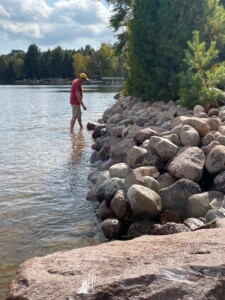Every spring, my wife and I kick off a big project on the grounds of our Northwoods lake property. We focus on areas of need, including dealing with erosion, reintroducing native plants, and protecting against or recovering from various tree diseases. Along the way, we take steps to incorporate features that blend with the environment and enhance the natural beauty and utility of the property. (The main image for this article is the view from our shoreline this fall. #Inspiration)
These are transformation projects.
And while the outcome is always exhilarating, the transformation process is messy, stressful, and exhausting. The projects invariably grow in scope, encounter unexpected obstacles, and demand that we constantly rethink our early assumptions and adapt.
 This year’s work involved bringing in 110 tons of fieldstone to protect a portion of our shoreline from further erosion and transforming a large sand beach. The beach is stunning in size, but much of the area was unused and contributed to the erosion issues. Our focus is adding in natural planting beds and other natural features. The initiative started in June, was scheduled to conclude in late July. We wrapped up for the year during the last weekend of October and still have finishing touches teed up for next spring.
This year’s work involved bringing in 110 tons of fieldstone to protect a portion of our shoreline from further erosion and transforming a large sand beach. The beach is stunning in size, but much of the area was unused and contributed to the erosion issues. Our focus is adding in natural planting beds and other natural features. The initiative started in June, was scheduled to conclude in late July. We wrapped up for the year during the last weekend of October and still have finishing touches teed up for next spring.
Applying the Lessons to Our Organization Transformation Efforts
Having led business transformation and worked with clients doing the same, I cannot help but see the parallels between our landscape and hardscape transformation initiatives and organizational ones. Over the years, we’ve developed our informal Guidelines for Success with these large-scale, disruptive projects. The guidance might serve you well with your workplace transformation initiative.
Seven Lessons in Transformation Learned in the Northwoods
1. Don’t Confuse Vision with Form
The experts are right; you have to have an overarching vision that excites, inspires, and solves a more significant challenge before starting any transformation initiative. Just don’t get married to the picture in your mind of what the final outcome will look like—it will invariably change form over time.
2. Find and Engage People Who Will Bring the Vision to Life
Several years ago, following a successful corporate transformation, I wrote an article about the need to give a visionary a voice. For our landscaping initiatives, my wife and I know the problem-to-be-solved and the opportunity-to-be-created, and we see an outcome. Yet, it’s Mark, a brilliant designer, who brings the vision to life for us. His deep experience, ability to understand what we are striving for, and genius ability to design to fit the environment are the difference makers.
3. Engage All Stakeholders; Especially the Ones Who Don’t Have a Voice
There are a lot of voices and votes in these transformation efforts, and the same applies in your workplace. In our case, there are permitting authorities and endless opinions and ideas from family members and friends. And then there are those who count but don’t have a voice. They need an advocate.
One might imagine inserting 110 tons of rock anywhere, much less a shoreline, would be destructive. While a few weeds are hurt along the way, Mark manages to ensure those large, heavy rocks are laid gently to protect and surround even the smallest tree seedlings. His goal is to create an environment for these young trees to grow strong and prosper. I once caught him hesitating with saw in, contemplating some low-hanging tree branches in his way. When I asked him what the issue was, he offered, “I’m asking the tree for permission to cut these branches.” He cut just the one and worked around the rest.
I suspect there may be a few eye rolls from the above anecdote, but there’s a more important lesson here. Some of the seedlings will grow into large beautiful trees. The roots will hold the shoreline together, and the benefits of the trees will be enjoyed by many.
Pay careful attention not to impose needless destruction on the environment during your transformation. There are always unintended consequences of our actions. Make sure yours aren’t on the negative side of the equation.
4. Make a Mess
Expect any transformation effort—home or workplace—to make a mess. There’s no avoiding that stage where what was once orderly now looks chaotic. I like order and process, and transformation brings disorder and the destruction of process. Yet, if I attempted to bypass the mess, I would likely fall short of the desired outcome.
Heavy equipment will leave tank tracks on your lawn, break a sprinkler head or two no matter how well they’re marked, and for a time, you’ll find equipment, supplier, and tools everywhere. It’s when the project gets the messiest that you know you are on your way toward your goal.
5. Ensure the Transformation Melds with the Surrounding Environment
Instead of putting a blot on the landscape, we strive to blend any changes we make with the environment. From our materials selection to avoiding sharp lines in favor of curves in our designs, every detail is intended to blend our work with the land that was here long before us.
 Yes, there’s change, and the only way to stay true to not impacting the environment is to leave it alone. However, we’re stakeholders in the process too. We are working to reduce the impact of erosion and incorporate features that fit in the environment while creating beauty and utility for us.
Yes, there’s change, and the only way to stay true to not impacting the environment is to leave it alone. However, we’re stakeholders in the process too. We are working to reduce the impact of erosion and incorporate features that fit in the environment while creating beauty and utility for us.
In our organizations, there’s a need to respect the culture but facilitate healthy change in every transformation. The organizational transformations that worked found a way to blend new ideas and talent with legacy strengths and passion. Alternatively, those that flamed out failed to respect the natural environment.
6. Embrace the Heavy Lifting.
 Sometimes, there’s no avoiding the reality that you have to move some rocks. Sure, the right equipment is priceless until the detailed work demands a delicate touch. When leading organizational transformation, you don’t get to sit back and supervise. It’s essential to jump in and feel the aches and pains from the work and then observe the results of your effort.
Sometimes, there’s no avoiding the reality that you have to move some rocks. Sure, the right equipment is priceless until the detailed work demands a delicate touch. When leading organizational transformation, you don’t get to sit back and supervise. It’s essential to jump in and feel the aches and pains from the work and then observe the results of your effort.
7. Adapt to Obstacles and Try Wild Ideas
For our latest project, Mark wanted to use large pieces of granite as steps into the water. After multiple attempts, the initiative failed, and we were left with an immovable object sitting as a barrier to water access. Eliminating the problem required added cost and some hefty destruction of the lawns when we brought out a big piece of equipment to remove the stone. This stone now sits in one of the shoreline gardens and is a fabulous feature. We will implement the alternative approach to the steps next spring.
The failure here offered an opportunity to think differently about what we were trying to accomplish and how we would do it. While the original vision was fantastic, it needed to be decomplexified and a more straightforward solution found. We added short-term costs but will enjoy long-term benefits.
Remember, focus on the problem to be solved and the opportunity to be created. The details will and likely should change on your way to success. Nothing works in reality as it is planned on paper. Be adaptable, and embrace the headaches as an opportunity to innovate.
The Bottom Line for Now:
I’ve long thought the best rules for leading change and solving problems come from our personal lives and initiatives where we are clear on our vision and unyielding in our commitment to the work. Our organization changes don’t feel like the work of transforming a shoreline or beach, but maybe they should. Imagine if the transformation team members viewed themselves as stewards of the environment and not experts playing with boxes on an organization chart in pursuit of trivial outcomes. I suspect more of those initiatives would succeed.
![]()







Leave A Comment